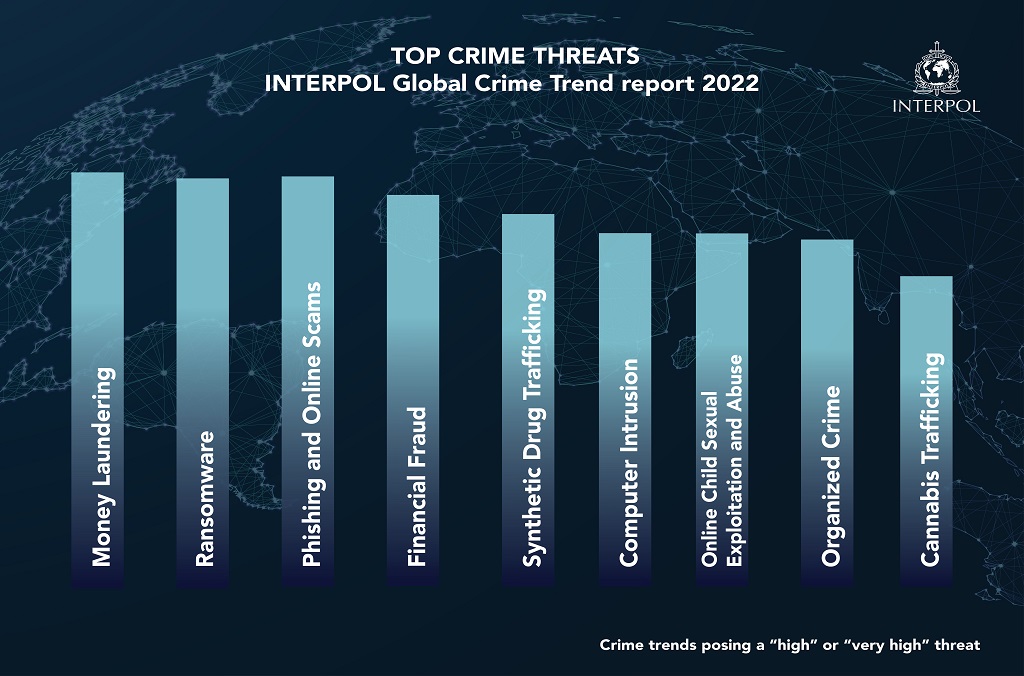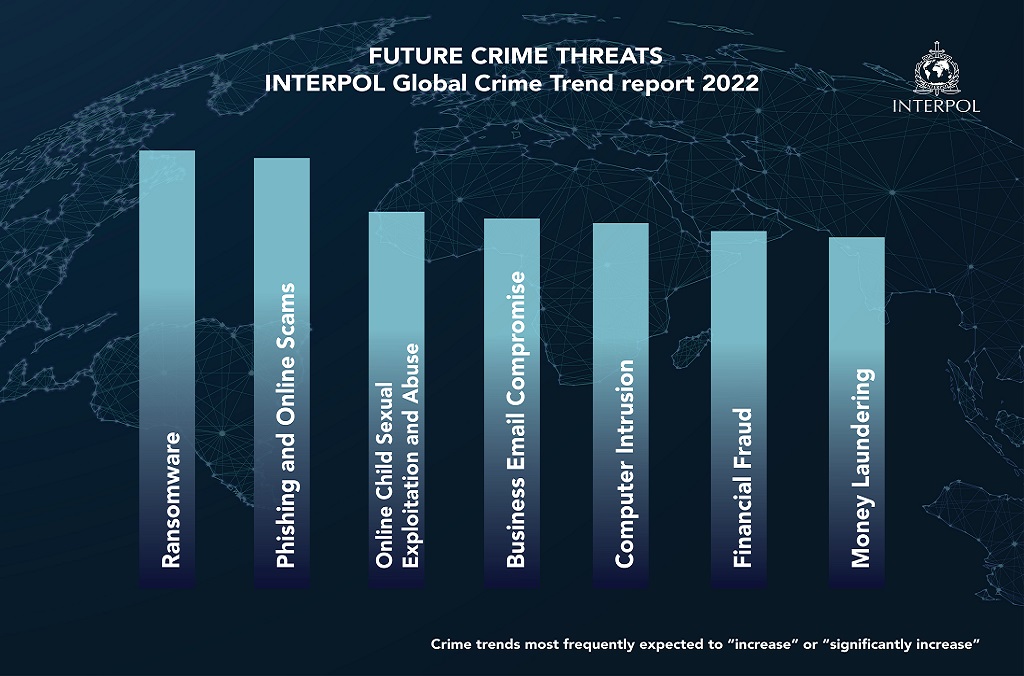NEW DELHI, India – Financial and cybercrimes are the world’s leading crime threats and also those projected to increase most in the future, according to a majority of the police respondents globally.
The findings, part of INTERPOL’s first-ever Global Crime Trend report, saw more than 60 per cent of respondents rank crimes such as money laundering, ransomware, phishing and online scams as high or very high threats.
Moreover, more than 70 per cent of respondents expect crimes such as ransomware and phishing attacks to increase or significantly increase in the next three to five years.
The report, which is restricted to law enforcement, brings together data received from INTERPOL’s 195 member countries alongside information and detailed analysis from the organization’s data holdings and other sources. Showing how crime areas converge in complex and mutually reinforcing ways, the report notes that understanding this complexity is crucial to inform collective decision-making by police worldwide.
“This initiative, which we will continue to build upon in the coming years, represents a genuine asset to law enforcement agencies across the globe,” the Secretary General added.
The report was presented at the 90th INTERPOL General Assembly meeting, taking place this week (18-21 October) in New Delhi.
Financial crime-as-a-service
Financial crimes and cybercrime are invariably linked, as a significant amount of financial fraud takes place through digital technologies (making it ‘cyber-enabled’) and cybercriminals also depend on financial fraud to launder their illicit gains. In this way, while ‘cybercrime-as-a-service’ is a well-known criminal concept, the pandemic has also hastened the emergence of ‘financial crime-as-a-service’, including digital money laundering tools that can prove critical for criminals seeking to cash out.
Respondents ranked money laundering as the number one crime threat in the INTERPOL report, with 67 per cent ranking it ‘high’ or ‘very high’ in their list. Ransomware was the second highest-ranking threat, at 66 per cent, and the crime threat expected to increase the most (72 per cent).

Most disturbing is perhaps the related rise in online child sexual exploitation and abuse (OCSEA), which 62 per cent of respondents expect to increase or significantly increase – the third highest-ranking future crime threat. The demand for, and production of, OCSEA materials also increased significantly during the pandemic.
While drug trafficking has traditionally dominated crime threat lists, cyber-enabled financial crime has increased precipitously in recent years, notably throughout the global COVID-19 pandemic. During and following lockdowns, rates of digitalization accelerated, with professional and personal activities performed almost exclusively from home and online.
Crime has also moved online, and cyber-enabled financial crimes, such as business email compromise, CEO fraud (where cybercriminals impersonate executives), e-commerce scams and investment fraud, have escalated in nearly every region. Today’s ransomware attacks target ‘big game’ targets, including major corporations, governments and critical infrastructure.
To maximize harm and illicit profit, strategies have shifted to techniques like double extortion, where victims’ data or files are both encrypted and threatened with public exposure, compounding the risks of business disruption and reputational damage.

Earlier this year, INTERPOL launched its Financial Crime and Anti-Corruption Centre (IFCACC) to provide a coordinated global response against the exponential growth in transnational financial crime. Just last month, an IFCACC-coordinated operation saw 75 suspected members of West-African financial crime rings arrested across 14 countries, intercepting more than USD 1 million and invaluable assets and intelligence along the way.
Two resolutions on strengthening INTERPOL’s response to both financial crime and OCSEA through increased engagement by member countries have been submitted to the General Assembly for approval.
A regional lens
Breaking down the results by five world regions, the INTERPOL report shows that while some crime threats rank highly across all geographical zones, others differ according to regional and national factors.
Africa
In Africa, phishing and online scams were deemed both the biggest current threat (83 per cent) and the crime most likely to increase in the next three to five years (72 per cent).
The leading role that African countries have played in mobile money transactions and the digitalization of the financial sector has brought countless advantages to the region. A byproduct of this rapid growth, however, is a sharp increase in online banking fraud, credit card fraud and cryptocurrency scams.
Human trafficking, drug smuggling and organized crime are also major concerns according to the report’s results.
Americas and the Caribbean
Illicit firearms trafficking was the top crime threat (88 per cent) in the Americas and Caribbean region according to respondents, ahead of ransomware (84 per cent) and OCSEA (83 per cent).
The INTERPOL report predicts that 3D printing will make it easier for criminals to create homemade weapons, including ‘ghost guns’ that can be produced without identifiers like serial numbers, making tracing illicit firearms more difficult. During a 2022 INTERPOL anti-firearms trafficking operation, authorities in St Kitts and Nevis made their first seizure of ghost guns, which were assembled using 80 per cent pistol frames.
Cybercrime topped the crimes that regional law enforcement perceive as future threats, with online scams, ransomware and business email compromise mentioned by more than 60 per cent of respondents.
Asia and the Pacific (APAC)
Financial crime was considered the top crime threat in the APAC region, specifically financial fraud (76 per cent) and money laundering (67 per cent), alongside the trafficking of synthetic drugs, which 67 per cent of respondents considered a high or very high threat. Synthetic drugs, or psychotropics, are also the second most frequently indicated drug type on INTERPOL notices or diffusions from the APAC region, the report notes.
Synthetic drug trafficking is expected to increase or significantly increase in the future according to 67 per cent of law enforcement respondents from the region, as well as cyber threats such as ransomware (79 per cent), phishing attacks, business email compromise, identity theft and online extortion (63 per cent respectively).
Europe
A substantial 76 per cent of respondents from Europe expect OCSEA to increase or increase significantly in the next three to five years. The INTERPOL report notes that the demand for livestreaming abuse has steadily increased in recent years, likely intensifying during the pandemic. While live distance child abuse most often take place in Southeast Asia, cases in the European Union have also recently been detected.
The top three threats currently facing Europe are phishing and online scams (62 per cent), money laundering (60 per cent) and synthetic drug trafficking (57 per cent), according to the respondents.
Middle East and North Africa (MENA)
The biggest crime threat, and the one most likely to increase in the near future, according to 89 per cent of respondents from the MENA region, is the trafficking of precursor drugs. Several sources mentioned in the INTERPOL report note that cannabis is the most pervasive criminal drug market in North Africa. However, the largest quantities of amphetamine – namely captagon – seized worldwide are consistently from the Middle East, where a majority of the drug is produced.
Cyber crimes, such as computer intrusion, phishing attacks and ransomware also ranked high among current (78 per cent) and future (89 per cent) crime threats. The reports notes that some Middle Eastern countries are among the most targeted nations globally for cybercrime, and that cybercriminals in this region appear to carefully select industries possessing sensitive customer data in hopes of maximizing financial gain.
Related documents
See also
Related news

INTERPOL returns to Vienna for centenary police conference
28 November 2023






